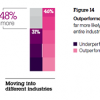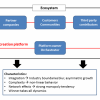In the course of this first month of 2016, I was asked a couple of times what my prospects are for the year ahead when it comes to key innovation issues. Hence, I gave it some thought, starting by revisting an earlier reflection: Beginning of 2013, Tim Kastelle and I identified four key issues in innovation management for the time […]
Tag Archives | Design Thinking

One Size Doesn’t Fit All Innovation
Yesterday, I was quite delighted to see my post Integrating Lean Startup and Design Thinking ranked #11 of the Top 100 Innovation Posts 2014 at Innovation Excellence. Once again, I was pondering why this post has been by far the most resonating one I’ve written up to now. My conclusion: many of us are aware that innovation tools, even up-to-date ones, have a limited scope […]

Innovation Success Requires Integrated Approaches
The resonance to my recent post on integrating Lean Startup and Design Thinking features to a combined process has been stunning. It really seems to have hit a nerve! Interestingly, it looks like others support the idea of balancing and combining elements of both innovation approaches, too. A couple of days after having had published my post, Paolo Lorenzoni from IDEO confirmed the complementary nature […]

Integrating Lean Startup and Design Thinking
Both Lean Startup and Design Thinking are promising approaches in order to target innovation. The Lean Startup concept is an appropriate choice for creating new businesses through development of an already existing idea or vision. Design thinking, on the other hand, might be preferred if the right business idea has not been found yet and customer needs or problems are still vague. Therefore, […]

Key Issues in Innovation Management
This post was co-written with Tim Kastelle from Innovation for Growth. What are the key innovation issues facing the business community right now? When we met up in person recently we had a great talk about this question. We’ve continued the discussion over email, and these are the four innovation management issues that we […]

Reconciling Organizational Improvement and Reinvention Through Social Business Design
This is the second part of a post co-written with Thierry De Baillon from Sonnez en cas d’absence. Read the first part here. A striking change of focus in the social business arena occurred during the last five years. Despite the fact that Andrew McAfee’s original definition specified its scope as «within companies, or between companies and […]

Business Model Innovation as Wicked Problem
This is the first part of a post co-written with Thierry De Baillon from Sonnez en cas d’absence. Read the second part here. We live in an age where emergent technologies continue to have massive effects on business and society. Rising complexity requires companies and economies to cope with increasingly interlocking systems. If we […]

Evolutionary and Revolutionary Innovation
Triggered by a couple of recent discussions, I’ve been pondering for a while now over the question how evolution relates to revolution when it comes to innovation. In the following, I’ll try to develop my view on this. Let’s define evolution as continuous and incremental innovations of a firm’s existing business. Whereas revolution can be […]

Innovators Hold Strong Visions Weakly
In one of my previous posts I discussed the crucial distinction between need and solution. Innovation is about matching these two components – i.e. solving a customer problem (desirability) through a viable business model, leveraging feasible products and services – in a novel way. It’s important to note that solutions are not represented by products […]

Innovation and Diversity
Tomorrow’s management systems will need to value diversity, dissent and divergence as highly as conformance, consensus and cohesion. A while ago, I came across this tweet by Gary Hamel. It reflects well the fact that businesses range in increasingly dynamic and complex environments, imposing accelerated and mostly unforeseeable change. The most promising way for organizations […]
Search
Recent Posts
- Dual Innovation: Ambidexterity 2.0 August 18, 2020
- Future-proof Companies: Combining Agility with Ambidexterity July 16, 2020
- Digital Innovation Units: Setting-Up for Scaling-Up June 27, 2020
- Digital Transformation: Dual Approach to Business Model Innovation June 14, 2020
- Dual Innovation at a Glance November 13, 2019
-
 A Model for Integrative Innovation Management
March 21, 2016
A Model for Integrative Innovation Management
March 21, 2016
-
 Integrative Innovation
February 19, 2013
Integrative Innovation
February 19, 2013
-
 Innovation and Organizational Culture
February 14, 2015
Innovation and Organizational Culture
February 14, 2015
-
 Balancing Innovation via Organizational Ambidexterity
May 29, 2013
Balancing Innovation via Organizational Ambidexterity
May 29, 2013
-
 Innovation and Serendipity
May 23, 2013
Innovation and Serendipity
May 23, 2013
-
 Leveraging New Ventures for Innovation
July 21, 2014
Leveraging New Ventures for Innovation
July 21, 2014
-
 Bad Innovation Systems Beat Good Innovators (Almost) Every Time
March 26, 2017
Bad Innovation Systems Beat Good Innovators (Almost) Every Time
March 26, 2017
-
 The Firm of the Future Will Manage Two Types of Businesses
January 20, 2017
The Firm of the Future Will Manage Two Types of Businesses
January 20, 2017
-
 Integrating Lean Startup and Design Thinking
February 1, 2014
Integrating Lean Startup and Design Thinking
February 1, 2014
-
 Balancing Innovation via Organizational Ambidexterity – Part 2
August 12, 2013
Balancing Innovation via Organizational Ambidexterity – Part 2
August 12, 2013
- Dual innovation (Ambidexterity 2.0) - InnoUpdate: […] Scaling up: The foundation […]...
- Innovation Follows Culture Follows Structure – Innovation Excellence - Reporter Inovation: […] previous ideas tie in with our proposed�...
- Innovation Follows Culture Follows Structure – Innovation Excellence - DLIT: […] preceding thoughts tie in with our propo...
- Innovation Follows Culture Follows Structure – Innovation Excellence |: […] preceding thoughts tie in with our propo...
- Innovation Follows Culture Follows Structure – Innovation Excellence | For Entrepreneurs and online business owners: […] preceding thoughts tie in with our propo...
- Innovation Follows Culture Follows Structure – Innovation Excellence: […] preceding thoughts tie in with our propo...
-
PostBox Communications: These aspects that will drive your digital transfo...
-
Srikanth Ramanujam: Interesting stuff. The intersection seems to be "...
-
Marek Stepan: The strength of the situtational forces was the ma...
- Intrapreneur vs Entrepreneur – Characteristics, Examples and Definitions | Success Unscrambled: […] June 2017, Ralph-Christian Ohr wrote abo...
Recent Tweets
- RT @ralph_ohr: The #DigitalTwin is a core metaverse building block. 🧩 Catch up on the latest insights around the emergent #IndustrialMetav… 2 years ago retweeted via ralph_ohr
- RT @ralph_ohr: Bringing a digital platform to the home heating services market: Lessons from @Thermondo https://t.co/O9XB67831y #innovati… 2 years ago retweeted via ralph_ohr
- RT @ralph_ohr: What are venture studios and how can they help with climate innovation? https://t.co/sy7xA8sg5s @wef #innovation #climate #v… 2 years ago retweeted via ralph_ohr
- RT @ralph_ohr: Exploring the Emotional Landscape of #Innovation https://t.co/EiOKENxLya 2 years ago retweeted via ralph_ohr
- RT @ralph_ohr: The new automotive mandate: Moving from building products to building businesses https://t.co/52Zc3PQU2E #innovation #busine… 2 years ago retweeted via ralph_ohr








